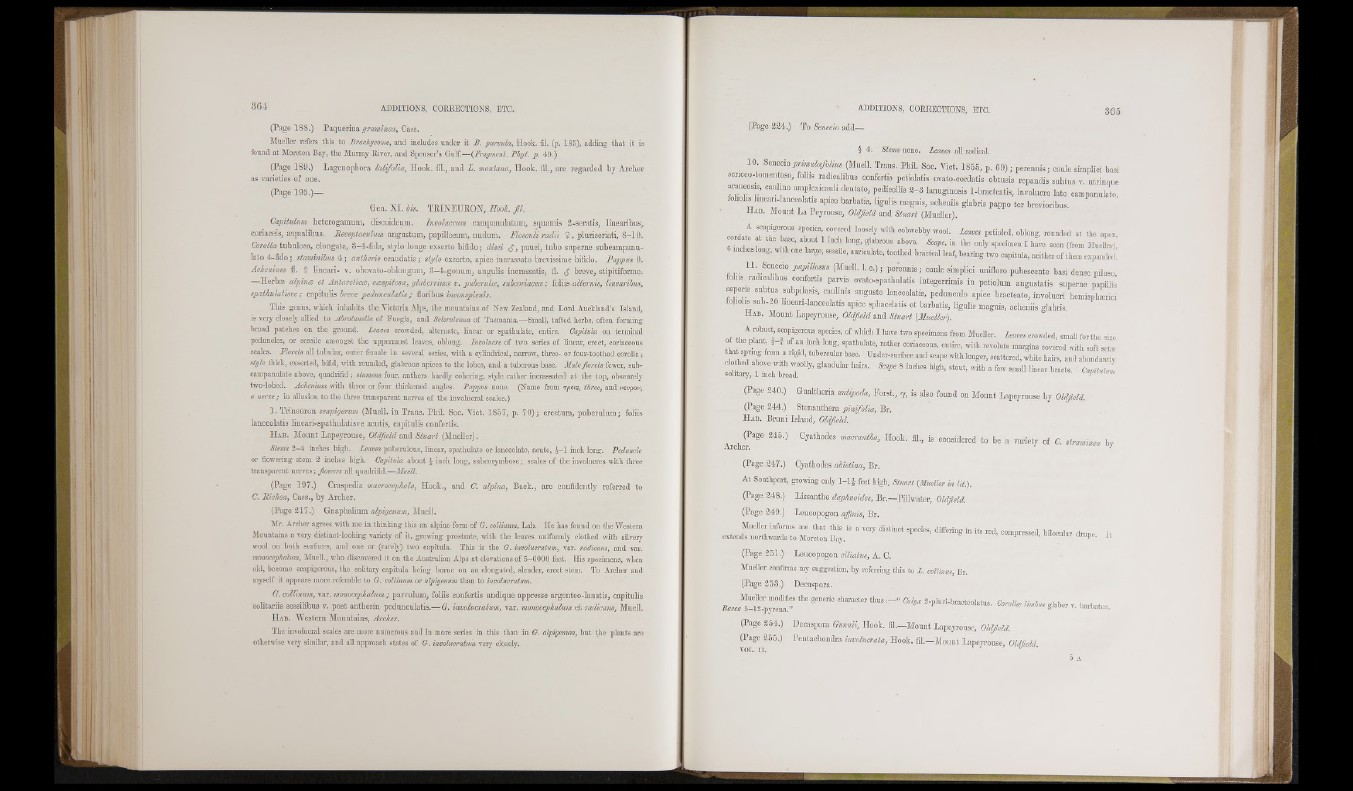
(Page 188.) Paquerina gramínea, Cass.
Mueller refers this to Brachycome, and includes under it B. parvula. Hook. ftl. (p. 185), adding that it is
fouud at îloretou Bay, the Murray River, and Spenser’s GxM.— (Fragment. Phyt. p. 49.)
(Page 189.) Lagenopliora latifolia. Hook, fil., and L . montana, Hook, fii., are regarded by Archer
as varieties of one.
(Page 195.)—
Gen. XI. iis. TEINEURON, Hook fil.
Capitulum heterogamum, discoidcura. Involucrum campanulatum, squamis 2-seratis, linearibus,
coriaceis, æqualibus. Eeceptactdum angustum, papillosum, nudum. Flosouli radii ? , pluriseriati, 8-10.
Corolla tubulosa, elongata, 3-4-fida, stylo longe exserto bifido; disci pauci, tubo superne subcampanu-
lato4-fido; staminièusé; aKtóem ecaudatis ; i/y/o exserto, apice incrassato brevissime bifido. Pappus 0.
Achemum fl. $ lineari- v. obovato-oblongum, 3 ^ -g o n um , angulis incrassatis, 11. $ breve, stipitiforme.
—Herbæ alpina et Antarctica, caspitosa, glaberrima v. puberula, subcoriacea; foliis alternis, lineanbus,
spathulatisve ; capitulis breve peduncidatis ; floribus inconspicuis.
This genus, which inhabits the Victoria Alps, the mouutaius of New Zealand, and Lord Auckland’s Island,
is very closely allied to Ahrotanella of Euegia, and Scleroleima of Tasmania.—Small, tufted herbs, often forming
broad patches ou the gixiund. Leaves crowded, alterante,. linear or spathulate, entire. Capitula ou terminal
peduncles, or sessile amongst the uppermost leaves, oblong. Involucre of two series of linear, erect, coriaceous
scales. Florets all tubular, outer female in several series, with a cylindrical, narrow, three- or four-toothed corolla ;
style thick, exserted, bifid, w'ith rounded, glabrous apices to tbe lobes, and a tuberous base. Male florets fewer, sub-
campanidate above, quadrifid ; stamens four, anthers hardly cohering, style rather incrassated at the top, obscurely
two-lobed. Achenium with tlu-ee ov four thickened angles. Pappus none. (Name from rpets, three, and vzvpov,
a nerve; in allusion to the three transparent nerves of the involucral scales.)
1. Trineuron scapigerum (Muell. in Trans. Phil. Soc. Yict. 1857, p. 70) ; erectum, puberulum; foliis
lanceolatis lineari-spathulatisve acutis, capitulis confertis.
H a b . Mount Lapeyrouse, Oldfield and Stuart (Mueller).
Stems 2-4 inches high, Leaves puberulous, linear, spathulate or lauceolate, acute, 4-1 inch long. Peduncle
or flowering stem 2 inches high. Capitula about 4 inch long, snbcorymbose ; scales of the involucres with three
transparent nerves; flowers all quadiifid.—Muell.
(Page 197.) Craspedia macrocepkala. Hook., and C. alpina. Back., are confidently referred to
C. Bichea, Cass., by Archer.
(Page 217.) Gnaphalium alpigenum, Muell.
Mr. Archer agrees with me in thinking this an alpine form of (?. collinum, Lab. He bas found on the Western
Mountains a very distinct-looking variety of it, growing prostrate, with the leaves uniformly clothed with silvery
wool ou both surfaces, and one or (rarely) two capitula. This is the 0. involucratum, var. radicans, and var.
monocepkalum, MuelL, who discovered it on the Australian Alps at elevations of 5-6000 feet. His specimens, when
old, become scapigerous, the solitary capitula being borne on an elongated, slender, erect stem. To Archer and
myself it appears more referable to G. collinum or alpigenum than to involucratum.
G. collinum, var. monocephalum ; parvulum, foliis confertis undique appresse argenteo-lanatis, capitulis
solitariis sessilibus v. post anthesin pedunculatis.— G. involucratum, var. monocephalum et radicans, Muell.
H a b . "Western Mountains, Archer.
Tlie involucral scales are more numerous and in more series in this than in G. alpigenum, but the plants are
otherwise very similar, and aU approach states of G. involucratum very closely.
ADDITIONS, CORRECTIONS, ETC.
(Page 224.) To Senecio add—
§ 4. Stems none. Leaves all radical.
10 (Muell. Trane. Phil. Soo. Viot. 1865, p. 6 9 ), peronnie; caule simplici basi
aeneeo-tomen 050, tolns radicalibus eouferlis petiolatis ovato-eordatis obtusis repaiidis subtus v. utrinoue
araneosis, eaul.iio ainplexioanli dentate, pedicellis 2 -3 lanuginosis 1-bracteatis, involnero late eampannlato,
foliolis Imean-laneeolatis apice barbatis, lignlis magnis, acheniis glabris pappo ter brevioribns
I-Ja b . Mount La Peyrouse, Oldfield and Sluart (Mueller).
t T f r ’f “ ’’ ““ "B . rounded at the apex,
long, „.tl. one large, sessile, anrical.te, toothed bracteal leaf, bearing two e.pitnia, neither of them expanded.
I I - Soueolo „ ¡ B o o m (Muell. i.e .) ; per'onnis; oanle simplici uniHoro pubescente basi dense piloso,
folt.s rad.cal.bns confertis parvis ovato.spatlinlatis integerrimis in petiolnm angustatis superne napill.s
aspem subtus snbp.losis, caulinis anguste ianceolatis, pednncnio apice bracteato, involucri hemispl.si.ei
foholis snb- 0 Imean-lanceolatis apice sphacelatis ct barbatis, lignlis magnis, acheniis glabris.
Hau. Mount Lapeyrouse, OUfieU aa) Sluart (Uueller).
A robust scapigerous speeies. of which I have two specimens from Mueller. Leave, crowded, smdl for the size
of he plant u to of an me . long, spathulate, rather coriaceous, entire, with revolute mnrgins covered with soft sets
“ h e d Z ^ r - r ’^^^^^ “ ‘‘» ■ ™ * » “ < i» a p e r a lh l„ „ g e r ,s c a t le ,.d ,w h ile h a ir s ,n n d n b u u d .u tlv
(Pago 240.) Gnaltl.eiia antifoia, Porst., y, is also found on iMonnt Lapeyrouse by OUfield.
(Page 244.) Stenanthera jiim/olia, Br.
H a b . Bi'uni Island, i
A r o h e f H o o k , hi., is considered to be a variety of C. etrammea b ,
(Page 247.) Cyathodes abietina, Br.
At Sontliport, growing only I - I 4 feet high, Stuart (Mueller in lit.).
(Page 248.) Lissantlie daphnoides, Br.—Pilhvater, Oldfield.
(Page 249.) Leucopogon afiinis, Br.
exteu “ r Z I r ^ : £ ) . ?=
(Page 251.) Leucopogon ciliatus, A. C.
aiucUev confirms my suggestion, by referring this to L. collinus, Br.
(Page 253.) Decaspora.
Mueller modifies the generic charaeter thus i - » Calga 2.plu,i-hracteolatus. C v lU U„6„ gl.ber v. barbatas
xsacca 5—iA-pyrcna.
(Page 254.) Decaspora Oumu, Hook, ffl.—Mount Lapeyrouse, Oldfield.
(Page 265.) Pciitaelioiidra inveluerata. Hook, ffl.—Mount Lapeyrouse, OlificU.